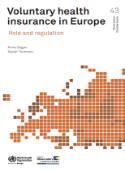Voluntary health insurance in Europe: role and regulation (2016)

Download
By Anna Sagan and Sarah Thomson
2016, xvii+ 122 pages
ISBN 978 92 890 5038 8
CHF 40.00/US$ 48.00
Order no. 13401168
If public resources were unlimited, there would be no gaps in health coverage and no real need for voluntary health insurance (VHI). Most health systems face fiscal constraints, however, and VHI is often seen as a way to address these pressures. This study draws from the experiences of 34 countries to assess VHI's contribution to health spending and to understand its role in Europe and in relation to publicly financed coverage. It looks at who sells VHI, who purchases it and why. It also reviews public policy on VHI at the national and European Union (EU) levels and the related national policy debates.
The analysis shows that, while the markets for VHI vary considerably in size, operation and regulation, the vast majority are small. The substantial markets tend to be the oldest, to have a tradition of non-profit insurers and to be the most heavily regulated to ensure VHI policies are accessible and affordable. The study also suggests that VHI is normally a better way of meeting the population's health needs than out-of-pocket payments, although there are notable exceptions. VHI can contribute to financial protection, especially where it plays a substitutive and complementary role covering co-payments. Nevertheless, it is a complex, challenging and highly context-specific policy instrument that may undermine other health-system goals, including equitable access, efficiency, transparency and accountability, even where markets are well regulated. Policy-makers should therefore exercise real caution before expanding VHI to fill coverage gaps.
This report is accompanied by a set of country profiles. The study draws on contributions from national experts from the countries in the EU and the European Free Trade Association, and other countries in the WHO European Region.



